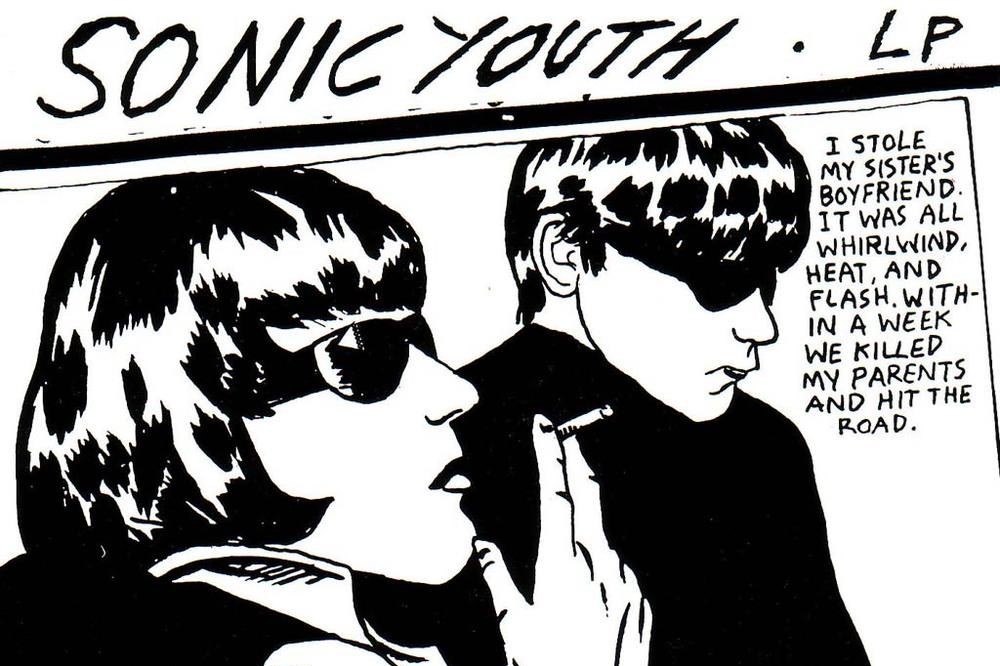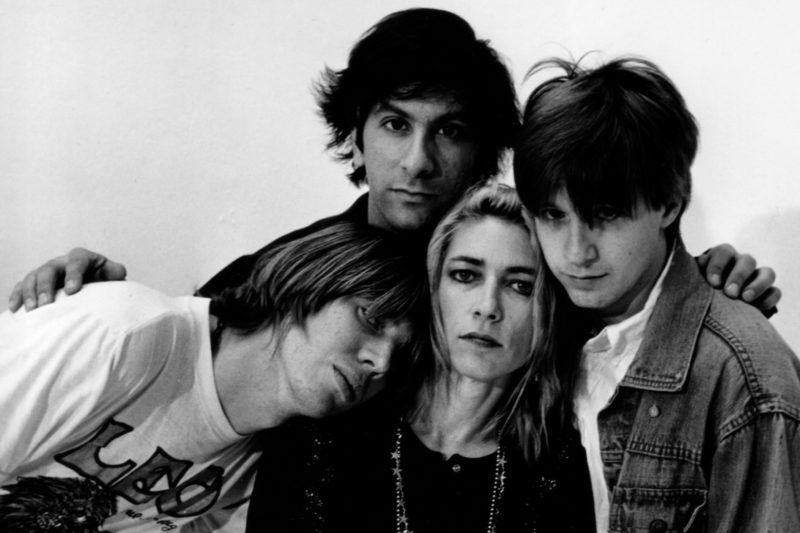The Initial Position
Sonic Youth have passed me by completely. While I did take rather deep dives into the pools of 60s rock and beyond, the underground scene of the 80s was something I did not yet care to explore. I think one of my only exposures to the band was the edgy chick in my art class that drew a rendition of the band’s iconic cover to Goo. Ever since she pops into my head whenever I hear the name Sonic Youth. So, music-wise this is still a pretty blank page for me. The only song I had previously listened to was Superstar from the If I Were A Carpenter Compilation. I especially liked the hazy numb feel of the track (looking back after this challenge I should have warned myself for what was to come).
Welcome to the (more or less) hopeless attempt of a blues fan to get into the Sonic Youth!
The Early Days
Okay, the early no-wave stuff reminds me of the time when I was preparing for my SWANS interview. The minimal tonal range and repetitiveness throughout the band’s self-titled recording and the studio album Confusion is Sex, are not up my alley. With primitive and random instrumentation, the albums sound like they were recorded in a kind of drug-induced haze – and maybe need exactly that to be an enjoyable listening experience. However, the percussive influences of Richard Edson on the debut and the funky bassline kicking off The Good and The Bad, are more engaging but quickly disappear into sonic chaos.
The albums sound like they were recorded in an outburst manner of experimentation and maybe require a special state of mind to be listened to. It is kind of like looking at a piece of modern art trying hard to grasp the meaning of it, but somehow a bunch of screwdrivers arranged to a triangle do not make a lot of sense and are not particularly interesting (I’m referring to a real-life experience here).
Fast Forward to the 21st Century
After failing to get into the band’s earlier no-wave records, which to me sound more like a random recording of noises coming out of instruments the way they never should, I decided to approach things a little differently. So, when the time came, I gave the latest Sonic Youth record, The Eternal, a spin. Here, the noisy cacophony has faded into the background a little, making the album more approachable. But as it often happens when a band, with a certain reputation, ages and gets further away from the youthful success of the earlier days, trying to keep up with the past can sound torturous. And so, it is on tracks like Ani-Orgasm, which desperately tries to hang on to the hard-core punk vibes the band resonated earlier without effort. But it fails to stick the landing and, instead, sounds like forced attempt to be punchy and provocative. As for the other tracks on the record, they have been a more endurable challenge to listen to than very early LPs, but are overshadowed by other bands who move in the alternative and indie rock circles today – which is apparently the audience that the Sonic Youth is attempting to penetrate now. Tracks like Poison Arrow or Antenna are easy to listen to but not memorable.
The Destroyed Room (2006)
I already dreaded pressing the Play when I saw the ten-minute length of the opening track to The Destroyed Room. Fire Engine Dream is an extended musical experiment that, while it is not completely unenjoyable, does not resonate with me on a deeper level than crying guitars and lazy drums. And yes, I am sorry I have to admit that I did not make it through the full song (sue me). Fauxhemians’ mellow beat is more catching – not only because of the soothing length of four minutes. A heavy bass line is something I have a weak spot for. The next track features distorted vocals by lead singer Kim Gordon and even some acoustic guitar slides (and it is only one minute long). Loop Cat is an interesting experiment, maybe even cinematic for certain moments. It conjures a surreal doomy vibe and would maybe be better off as soundtrack to an edgy short film.
Murray Street’s opening track is basic alternative rock until it turns into strange experimentation of screeches, I am not able to listen to. The entire 2002 record moves between alternative rock, progressive experimentation, and hard rock – listenable but not memorable.
90s Kids
Washing Machine starts on the promising Becuz. The grungy guitar riffs hit the right note of unpolished and gritty without drifting off into complete noise (but balancing on the brink of it). Yet, I guess one of the main problems I have with the Sonic Youth, as it has become apparent over the past few days, are the vocals by Kim Gordon. The punky coldness is, of course, what she is going for, but when you are used to the emotive vocals of Janis Joplin or David Byrne, it is hard to get won over by the screams of the singer. Especially when outfits like Porridge Radio show us how you can get pretty damn punk and still have emotional power in your voice.
However, Becuz is the first song that I might find myself returning to in the future, as I did enjoy the shifts of dynamic and the fuzzy distortion of the lead guitar over the driving rhythm riff. In all of its cacophony and chaos, Washing Machine seems to find a musical order making it more palpable to anyone not born in the times of 80s underground rage. Also, with its line-up of three guitars instead of two, had to somehow resonate with me.
Saucer-Like, features male vocals by singer Thurston Moore and, with its bendy guitar parts and distinguishable riffs actually resonates with me. Even the Wha Wha pedal found use and the spoken-word style vocals, almost sounds like a male Patti Smith had paired up with an amateur Jimi Hendrix. As for the rest of Washing Machine, it follows the mood the first three songs foreshadow. No Queen Blues sounds similar to Saucer-Like, the title track is a textbook punk fiasco and the epic 20-minute closing track The Diamond Sea ranges from everything in between the two, boiling down the two opposing sides this band combines; almost aggressive noise and hazy alternative rock.
A Thousand Leaves (1998)
Contre Le Sexism, the opening track is a minimalistic experimentation. With Kim Gordon aching to swelling sounds that could come from a construction site, it is as strange as it is intriguing. It is not my cup of tea, but I certainly see the artistic value in the spoken-word style narrative paired with experimental beats. Almost as if recorded in the next room while the drummer was practicing by himself, the musicians do not line up and, instead, of providing a gluing element, the vocals widen the gap between the instruments; an interesting experiment and a unique approach.
Okay, it’s not Sunday but on Sunday I arrived at the Sonic Youth. This is the first track that has me embracing the cacophonic chaos the band creates with their instruments. I feel A Thousand Leaves, but still the songs could have all been shortened by half. So far, this is the most soft-core record in the discography and one people who are not into this type of music can fully enjoy (more or less, there might have to be some fast-forwarding action through the rough bits).
Sunny Days
I like the numbed feel of Hits of Sunshine (For Allen Ginsberg), its minor tonality is somehow off, like a cracked whisper. At first, I was dreading the eleven-minute length but now, five minutes in, I am actually excited to hear what the other six hold. It feels like these two albums meet the golden middle ground between drugged experimental jams that are hardly enjoyable when you’re not under the influence and get the curve before the band tried to forcefully keep up with the reputation on recent releases.
But maybe I was too fast to give this away. Karen Koltrane is, again, a cacophony and painful to listen to. Without any musical order, the chaos is something that I do not draw any value from. Snare Girl, then takes another turn and features soft hushed whispers by the male vocalist. It feels almost too warm and pleasant and I am waiting for the distortion to jump back out at us to shred eardrums. But, to my surprise it does not come!
Dirty (1992)
It’s getting Dirty. The groove of 100% immediately catches me – what should not come as a surprise to anyone by now. The tight drumbeat and the screechy guitars sound less punky than the other stuff the band put out and with the raw vocals, move in the alternative rock terrain. Too bad, the track only lasts shy two-and-a-half minutes. Even in the absolute noise of Theresa’s Sound-World, I can by now find joy. The dynamic shifts from the mellower bits to the pure ecstatic noise follow a silver lining. The snarly drawl of the vocals fuses the two personas of the song, giving the mellow parts, edge and gently preparing for the crescendo ahead. This must have been a hell of a live show, I keep thinking while listening to the track. Here, they manage to push the guitar solo as far as possible without scaring off less hardcore listeners. Just before I would have had to skip a part; they fade back into the rhythmic groove.
The dark moody gloom of Shoot – no subtlety here – creeps up on the listener like a slow-burning haze, blurred and faded. Kim Gordon’s numb vocals sound restrained and without their screechy edge, melt over the bed of instrumentation in an almost Patti Smith-like style of intonation; shouted and growled, gritty but not in an annoying eardrum torturous punk way. Crème Brulee moves from extreme experimentation to almost folky or country-esque groove. ‘Last night I dreamed I kissed Neil Young’. Sonic Youth add a gothic twist to folky vibes. Personality Crisis sees the band branch out further as it even features acoustic guitar. ‘You got the personality crisis while it was hot, but now frustration and heartache is what you’ve got.’ The lyrics dwell on the general mood of anger, tiredness, and depression prominent in the frustration driving the music of the underground.
The Iconic Album

The infamous “Goo” artwork
Listening to the discography from front to back, I have encountered the more immediate effects of Kim Gordon stepping up as a songwriter and guitarist, but Goo features her first dabbles in the territory. With it, come different topics. Themes of female empowerment reoccur on songs like Tunic and Kool Thing. The former is an exploration of the female body image in society, inspired by Karen Carpenter’s struggle with anorexia. Greeting famous LA musicians, Janis, Elvis, Kim Gordon tells the story of a musician with big dreams being told; ‘you are never going anywhere’. Screechy guitars amplify the feeling of the industry breaking its artists. The Sonic Youth take a critical look at the mythos of stardom in the music industry and at how one can disappear into fame. Getting smaller and smaller, while getting bigger in someone else’s eyes, until finally getting eaten up by the industry. It is an engaging dissection of the music scene at that time, which in some ways, is still the same today.
‘I feel like I’m disappearing, getting smaller every day
But when I open my mouth to sing, I’m bigger in every way’‘Hey mom! Look I am up here, I finally made it!’
Kool Thing criticizes misogynistic views of rap music with edgy grunge-rock arrangements and punchy confrontational lines. This is not something I admire for the instrumental skill (like I do other artists), but for the message transported through their way of playing. ‘Are you going to liberate us girls from male white corporate oppression?’. This is music to rage to, not to contemplate the genius of every single note of a guitar solo.
The Verdict
It has been a tough week with Sonic Youth. Especially, the early records really tried my patience. I am glad I fought my way through because now I can say with confidence that the early works are not my kind of music. But listening to the band evolve over the course of their discography from youthfully energetic noise to more reflected and artistic experimentations, to forcefully trying to keep up with the image they had created for themselves – was quite the ride. Records like Goo, Washing Machine and A Thousand Leaves resonated with me the most. Here, the band found the balance between the noisy experimentation and too noisy experimentation and paved the way for other alternative rock bands.
The 80s were a time for noise and rebellion. The band set an important milestone by bringing attention to the music of the underground. Furthermore, Sonic Youth shaped the path for modern musicians. But, if you are not massively into noise, punk, and no-wave, you are better off skipping out on the early works of these guys. There were some interesting moments along the way and a bunch of tracks I will maybe return to in the future. But in the end, I do not feel the need to add a Sonic Youth LP to my collection – the ultimate test.
▶ Experience more Lockdown Listening Challenge diaries from our staff right here.



